Trip Report - 8-4-19
The plan for the day was to fish different weights of the Shimano Slim Swimmer spoons. For some time now, I have had the 2.5g Slim Swimmer spoons but they also come in 1.5g, 3.5g and 5g weights. Shimano also has a "Compact Edition" Slim Swimmer that has the same length and width as regular Slim Swimmers, but is stamped from a thicker metal. The 2g Slim Swimmer CE (Compact Edition) is the same size as the regular 1.5g Slim Swimmer. On Sunday, I had gold Slim Swimmers in 1.5g, 2.5g, 3.5g and 5g, and the Slim Swimmer CE in 2g.
I decided to try the different weights of the Shimano Slim Swimmers after my
trip a few weeks ago when the Slim Swimmer was the only spoon to draw any
strikes. The fish don't say, but I suspect at least part of the reason for the
Slim Swimmer's effectiveness is that it is a lot closer than most spoons
to the shape of a real minnow. Another possible reason for their effectiveness is that their action is a bit more subtle than that of some other spoons. That might make them more attractive to the fish, but it also might make it easier for the fish to actually hit one. I have seen fish miss other spoons repeatedly.
Another reason for wanting to try the 1.5g weight is because that is close to the lightest
weight that I can cast effectively with my BFS gear. Plus, it's not much
larger than the Daiwa Vega spoons, which have proven their effectiveness for
everything from bluegills to creek chubs to smallies to trout. I know that smaller spoons are much more effective than larger ones when fishing for bluegills, and I had a sneaking suspicion the same would be true for the smaller trout in headwaters streams.
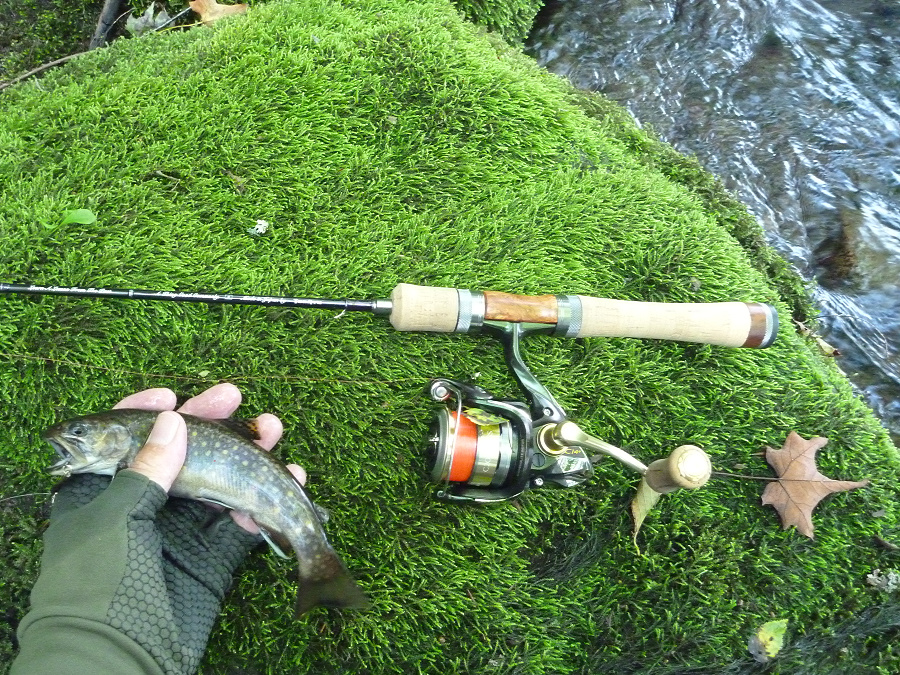 Tenryu Rayz Spectra RZS51LL
Tenryu Rayz Spectra RZS51LLI started out with a Tenryu Rayz Spectra RZS51LL spinning rod. It's been a while since I have fished it and I do like it quite a lot. It is rated for lures as light as 1g, and the 1.5g Shimano Slim Swimmer cast very nicely with it. I was on a pretty small stream, so casting was for accuracy, not for distance. I could have stayed with the Spectra and the 1.5g Slim Swimmer and had a very nice day indeed, but I had other lures to fish.
After a couple fish I switched to a Tenryu Rayz RZ53UL-BC with a Daiwa SS
Air reel and the 2.5g Slim Swimmer. Although I can cast the 1.5g spoon with the
Tenryu baitcaster and a BFS reel, the 2.5g spoon casts much more easily and much more accurately.
I don't have any photos with the Daiwa SS Air from this trip because I fairly quickly became disappointed in the line I had on it. On Saturday evening I spooled it with 3# Sunline Troutist Wild - which I have used many times before and have been very happy with. However, that was before I fished with the Sunline Small Game PE-HG braid!
Daiwa cautions that you should not use braid with the SS Air. However, when they list the line capacity, they give the capacity for 8 lb nylon. The Sunline Small Game PE-HG braid I have is 6 lb. That's not "6 lb diameter" it's 6 lb breaking strength. I always use some tippet between the braid and the lure, usually Varivas 5X nylon, which has a breaking strength of 4.7 lb. If Daiwa thinks the reel is safe with 8 lb nylon, I think I am safe with 6 lb braid and 4.7 lb tippet!
On Sunday, I also brought a Daiwa Alphas Air Stream Custom reel, which was spooled with the Sunline Small Game HG-PE braid. I switched to the Air Stream Custom and stayed with it for the rest of the day. I like the Daiwa SS Air (and actually prefer it to the Shimano Aldebaran), but I must say I greatly prefer the braid over the nylon line. I do not think I will spool a baitcaster with nylon again.
With braid, it seems that a slight overrun is much, much less likely to develop a serious birds nest. It seems braid WANTS to stay on the spool but nylon WANTS to leap off, which definitely contributes to birds nests. I think the nylon, even 3 lb nylon, is stiffer and slicker than 6 lb braid, which means that given half a chance, it won't stay tight to the spool.
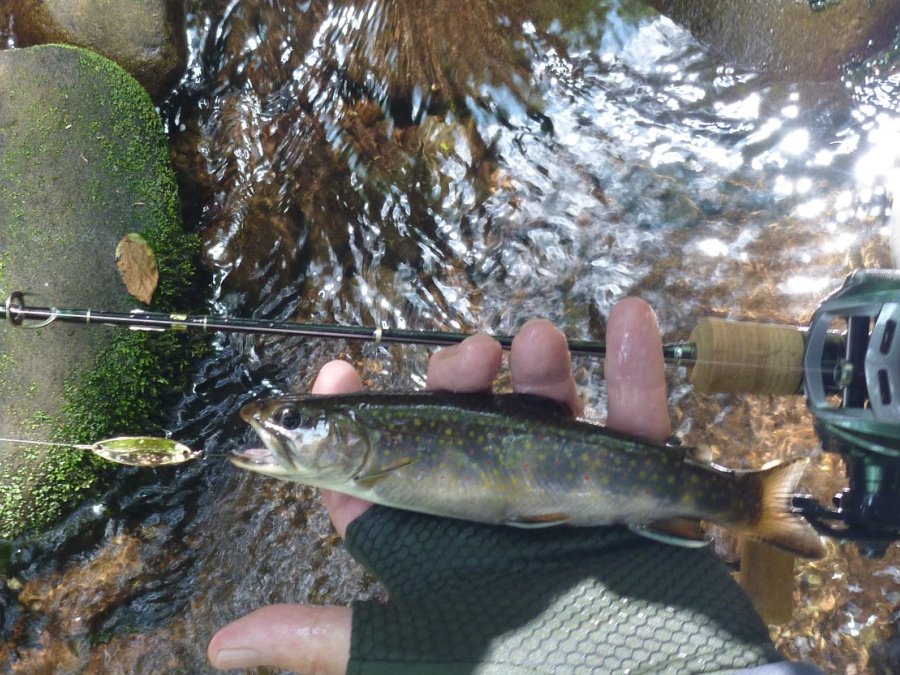 Shimano Slim Swimmer 2.5g fooled this brookie.
Shimano Slim Swimmer 2.5g fooled this brookie.After switching reels, I spent about half my remaining time with the 2.5g Slim Swimmer and about half with the 3.5g Slim Swimmer. Both were extremely effective at drawing strikes. There was a huge difference in the number of fish in the net, however.
I have mentioned this enough times before that by now it is no secret: I have a very, very hard time getting 6 and 7 inch trout to stay on barbless hooks. I lose some on the way in, but the closer to the net, the more likely a fish will get off. I bring a fish to the surface so I can see it to net it. Wriggling like crazy on the surface, though, they are very good at throwing the hook.
It turns out that the 3.5g spoon is just heavy enough and has just enough inertia that when a small fish starts to wriggle, the spoon is still zigging when the fish starts to zag and the hook just slides right out of its mouth. I don't now how many fish I hooked with the 3.5g spoons, but it was enough that they alone would have given me a "many" day. I did not get even one of them into the net, though. Bigger fish, which don't wriggle as quickly, aren't hard to land with barbless hooks.
All the fish I hooked with the 3.5g spoon appeared to be in the 5-7 inch range. That pretty much proves, at least to my satisfaction, that you don't have to fish tiny little lures even if the trout you expect to catch are pretty small. I am increasingly of the opinion that the desire to cast the lightest possible lures on BFS reels is a lot more about the casting than the fishing. Casting the lightest possible lure is a challenge - whether or not it results in more fish. Smaller lures may indeed be more productive when fishing for highly pressured fish, but at least where I was on Sunday, the 3.5g spoon seemed to draw just as many strikes as the much smaller 1.5g spoon.
Even though I had serious problems keeping the 5-7" fish on the barbless hook, I do like the 3.5g spoons. They cast very nicely indeed with a baitcaster - or perhaps I should say with my skill level, they are easier to cast, and to cast accurately, than the lighter spoons. I am no Angler Saito by any means, but at least a few times I was able to cast the 3.5g spoon right to kitchen-sink-sized spots between rocks along the shore, and then get hits as I retrieved the spoon into the current.
Update - 8-11-19
On a fishing trip that was intended to be primarily keiryu fishing, I took some time to use a Shimano Slim Swimmer 3.5g spoon on which I had replaced the original barbless hook with a Cultiva S-21 microbarbed single hook. I was able to catch several 6-7" fish without having any wriggle off the hook.
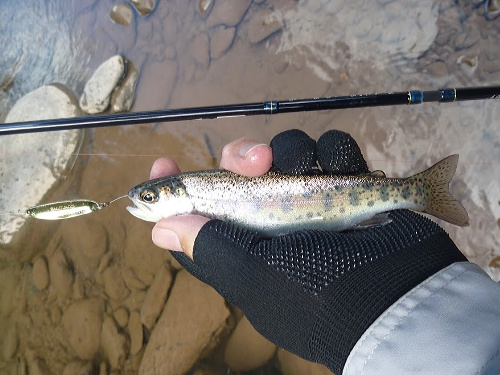 Shimano Slim Swimmer 3.5g fitted with replacement Cultiva S-21 microbarb single hook.
Shimano Slim Swimmer 3.5g fitted with replacement Cultiva S-21 microbarb single hook.I saw a YouTube video recently that claimed to teach
how to fish spoons in small streams. There is no way I would fish spoons
in streams the way the video recommends. First, the guy in the video maintained that you should
never fish upstream because a spoon is heavy and will fall to the bottom
and get snagged in rocks. I fish upstream almost all the time. I almost never get the spoon snagged in rocks.
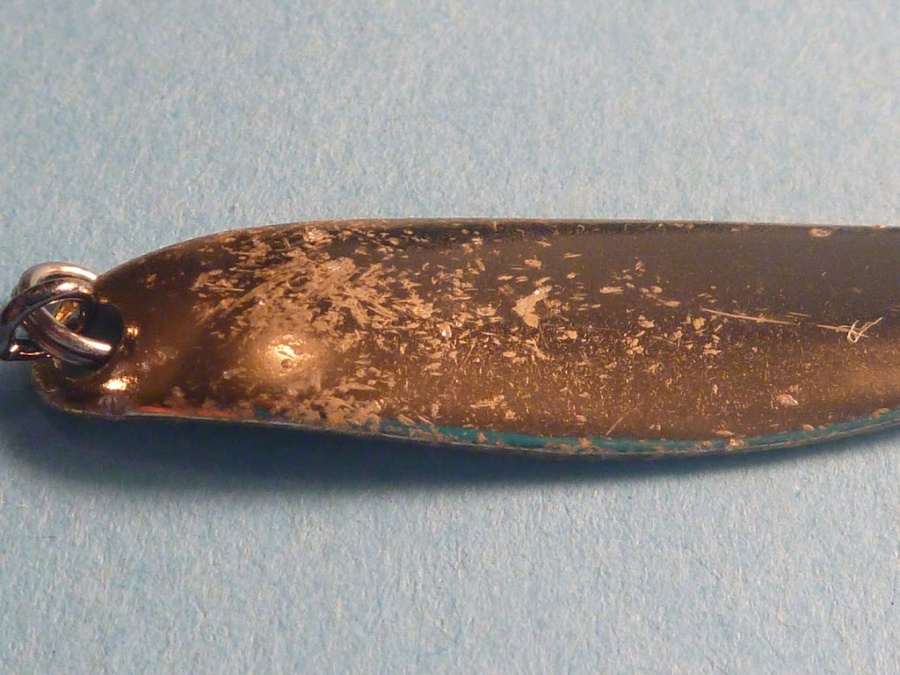 Scratches from river bottom rocks
Scratches from river bottom rocksThe photo above shows scratches on the 3.5g spoon I fished Sunday, caused by rocks on the river bottom. The spoon was brand new, right out of the package when I
tied it on. The water was low and it is obvious that the spoon spent a lot of
time sliding over rocks. It did not get snagged on rocks even once all
day long. I think there are two main reasons for that.
First and foremost, I fish spoons that have a single hook rather than a treble hook. If you fish a spoon slowly, as you should, the side of the spoon you would normally think of as the top (where all the scratches are in the photo above) is actually on the bottom, facing the bottom of the stream.
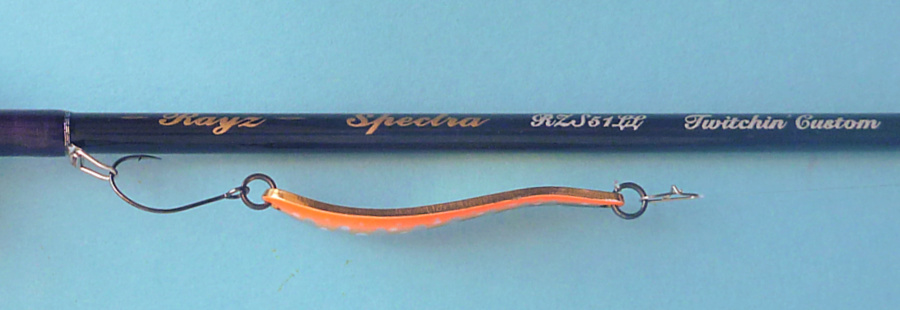 This is how a spoon goes through the water when fished slowly:
This is how a spoon goes through the water when fished slowly:curved side down, hook pointing up.
(The spoon shown is a Forest Marshal River spoon,
which has an exagerated shape, making it easier to see the convex nature.)
A spoon wobbles and rolls, but the convex side of the spoon (the scratched side) will be facing down when the spoon is fished slowly. When a spoon is fitted with a single hook, the hook point is opposite from the convex side of the spoon. Thus, the hook points up when the spoon is fished slowly. With the hook pointing up and the curved side of the spoon facing down, the spoon slides over rocks without getting snagged. If a spoon is fished too fast, it will spin rather than wobble, so the hook will not stay pointing upwards.
The second reason for no snags is that I start reeling as soon as the spoon hits the water. Watching the guy's video, it was clear that he cast out, the spoon hit the water, then he closed the bail on his spinning reel and then he started reeling, and he was not terribly quick about it. That delay between the time the spoon hit the water and when he actually started reeling definitely would give the spoon time to fall down between rocks, where the treble hooks would catch.
Personally, I find it much, much easier and quicker to start reeling with a baitcaster than with a spinning reel. The handle has two knobs instead of just one, so it is much easier to find a knob to start reeling. Also, there is considerably less resistance to engage the clutch with a baitcaster than to trip the bail by starting to reel a spinning reel. With a BFS reel, it is very easy to start reeling the instant your spoon hits the water, so it doesn't have a chance to fall to the bottom and get caught between rocks. Flipping a spinning reel bail by hand and then trying to find the handle knob can take way too much time - even if you aren't as slow as the guy in the video was. (It's no wonder he won't cast upstream!) If you fish a spinning reel, you will have to close the bail and start reeling instantly!
Instead of casting upstream, the video instructed to cast across or across and down. He fishes a spoon on the swing, just letting the current flow past the spoon, which gives it the action. The problem is that the current in most mountain streams is too fast for optimal spoon action. The spoon won't wobble lazily or roll from side to side. It will spin. Retrieving a spoon too quickly, or fishing it downstream in current that is too fast will give you as much line twist as you'd get with a spinner. One of the main advantages of a properly fished spoon is no line twist. Fish a spoon too fast and you might as well fish a spinner.
The guy in the video extolled the virtues of his 10 lb braid, saying it handles line twist better than nylon. You know, if he fished his spoons differently, he wouldn't have to worry about line twist - and he certainly wouldn't have to use 10 lb line!
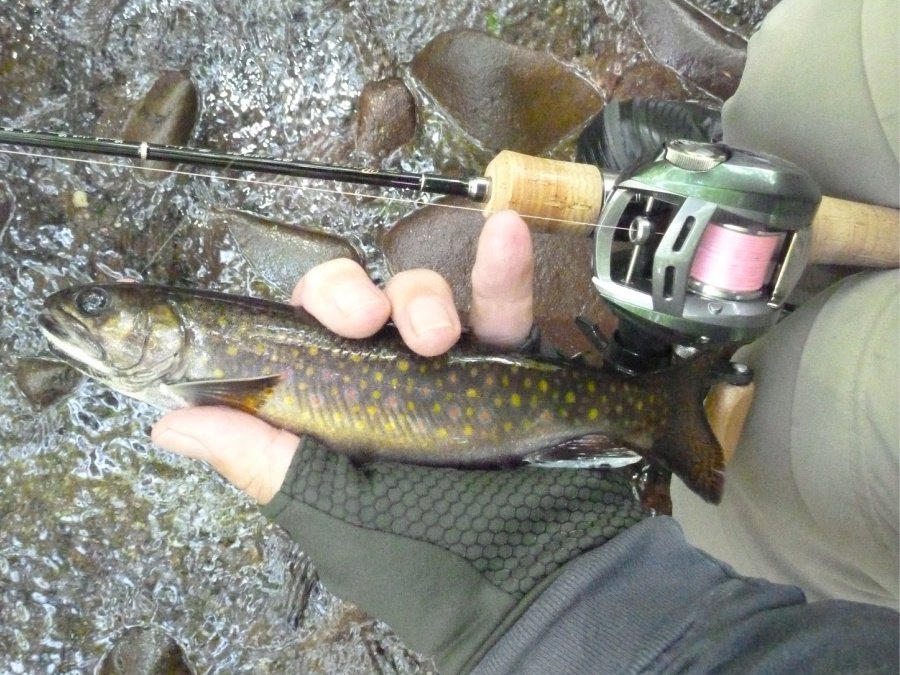 A spoon retrieved just above the bottom took the biggest fish of the day.
A spoon retrieved just above the bottom took the biggest fish of the day.Also, a spoon fished downstream in fast current will be forced to the surface. Most of the fish are going to be near the bottom. If you fish a spoon upstream and retrieve just a bit faster than the current, the spoon can get down to where the fish are.
Enough ranting about YouTube "experts." Just remember, owning a GoPro does not automatically make one an expert fisherman.
Getting back to the Shimano Slim Swimmers, I fished the 2g Compact Edition Slim Swimmer very briefly - just long enough to decide I liked the action of the standard weight spoon better. I am sure that the Compact Edition would cast further and fish deeper. On the small, shallow stream I fished Sunday, neither of those attributes was needed.
Towards the end of the day, I also fished the 5g spoon for just a few casts. I fished it only briefly because within minutes it started raining. I hadn't brought a rain jacket, as rain had not been in the forecast. It was getting close to the time I had to head back anyway so I packed it in and started for home.
I will definitely spend more time fishing the 5g spoon, though. It is almost the size of the 50mm heavy sinking minnow plugs, but but it already comes with a single hook and is about half the price of most JDM plugs. The shape isn't as radical as the Forest Marshal River spoons, so the action is more subtle. It may end up being a very nice lure.
Header photo: Tenryu Rayz RZ4102B-UL, Shimano Calcutta Conquest BFS-HG ('17)
Warning:
The hooks are sharp.
The coffee's hot.
The fish are slippery when wet.
Seriously, all the hooks sold on Finesse-Fishing.com, whether packaged as loose hooks or attached to lures, are dangerously sharp. Some have barbs, which make removal from skin, eyes or clothing difficult. Wear eye protection. Wear a broad-brimmed hat. If you fish with or around children, bend down all hook barbs and make sure the children wear eye protection and broad-brimmed hats. Be aware of your back cast so no one gets hooked.
Also, all the rods sold on Finesse-Fishing.com will conduct electricity. Do not, under any circumstances, fish during a thunder storm. Consider any fishing rod to be a lightning rod! Fishing rods can and do get hit by lightning!
Whatever you do, do it with finesse!